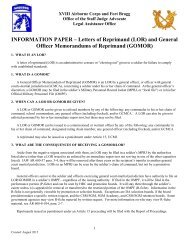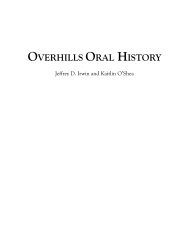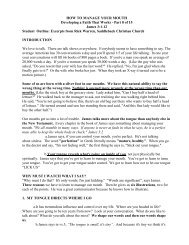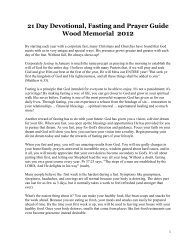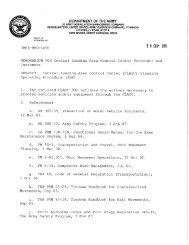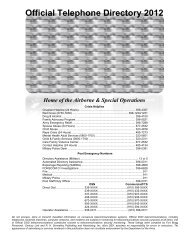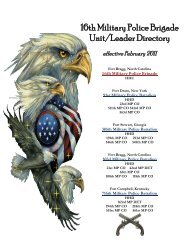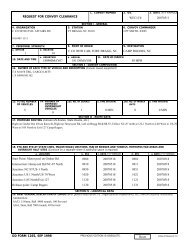Articles 120, 120b, 120c, 43, and 118, UCMJ – DoD Proposed ...
Articles 120, 120b, 120c, 43, and 118, UCMJ – DoD Proposed ...
Articles 120, 120b, 120c, 43, and 118, UCMJ – DoD Proposed ...
You also want an ePaper? Increase the reach of your titles
YUMPU automatically turns print PDFs into web optimized ePapers that Google loves.
<strong>Articles</strong> <strong>120</strong>, <strong>120</strong>b, <strong>120</strong>c, <strong>43</strong>, <strong>and</strong> <strong>118</strong>, <strong>UCMJ</strong> <strong>–</strong> <strong>DoD</strong> <strong>Proposed</strong> NDAA FY 11 Amendments, as<br />
included in S. 3454 by Senate Armed Services Committee, June 4, 2010<br />
made a threat, it need not be proven that the person actually intended to carry out the threat or<br />
had the ability to carry out the threat.<br />
(f) MARRIAGE.—In a prosecution under subsection (b) (sexual assault of a child) or<br />
subsection (c) (sexual abuse of a child), it is a defense, which the accused must prove by a<br />
preponderance of the evidence, that the persons engaging in the sexual act or lewd act were at<br />
that time married to each other.<br />
(g) CONSENT.—Lack of consent is not an element <strong>and</strong> need not be proven in any<br />
prosecution under this section. A child cannot consent to any sexual act, lewd act, or use of<br />
force.<br />
(h) DEFINITIONS.—In this section:<br />
(1) SEXUAL ACT AND SEXUAL CONTACT.—The terms ―sexual act‖ <strong>and</strong> ―sexual<br />
contact‖ have the meanings given those terms in section 920(g) of this title (article<br />
<strong>120</strong>(g)).<br />
(2) FORCE.—The term ―force‖ means—<br />
(A) the use of a weapon;<br />
(B) the use of such physical strength or violence as is sufficient to<br />
overcome, restrain, or injure a child; or<br />
(C) inflicting physical harm.<br />
In the case of a parent-child or similar relationship, the use or abuse of parental or similar<br />
authority is sufficient to constitute the use of force.<br />
(3) THREATENING OR PLACING THAT CHILD IN FEAR.—The term ―threatening or<br />
placing that child in fear‖ means a communication or action that is of sufficient<br />
consequence to cause the child to fear that non-compliance will result in the child or<br />
another person being subjected to the action contemplated by the communication or<br />
action.<br />
(4) CHILD.—The term ―child‖ means any person who has not attained the age of<br />
16 years.<br />
(5) LEWD ACT.—The term ―lewd act‖ means—<br />
(A) any sexual contact with a child;<br />
(B) intentionally exposing one‘s genitalia, anus, buttocks, or female areola<br />
or nipple to a child by any means, including via any communication technology,<br />
with an intent to abuse, humiliate or degrade any person, or to arouse or gratify<br />
the sexual desire of any person;<br />
(C) intentionally communicating indecent language to a child by any<br />
means, including via any communication technology, with an intent to abuse,<br />
humiliate or degrade any person, or to arouse or gratify the sexual desire of any<br />
person; or<br />
(D) any indecent conduct, intentionally done with or in the presence of a<br />
child, including via any communication technology, that amounts to a form of<br />
immorality relating to sexual impurity which is grossly vulgar, obscene, <strong>and</strong><br />
repugnant to common propriety, <strong>and</strong> tends to excite sexual desire or deprave<br />
morals with respect to sexual relations.<br />
§ 920c. Art. <strong>120</strong>c. Other sexual misconduct<br />
(a) INDECENT VIEWING, VISUAL RECORDING, OR BROADCASTING.—Any person subject to<br />
this chapter who, without legal justification or lawful authorization—



